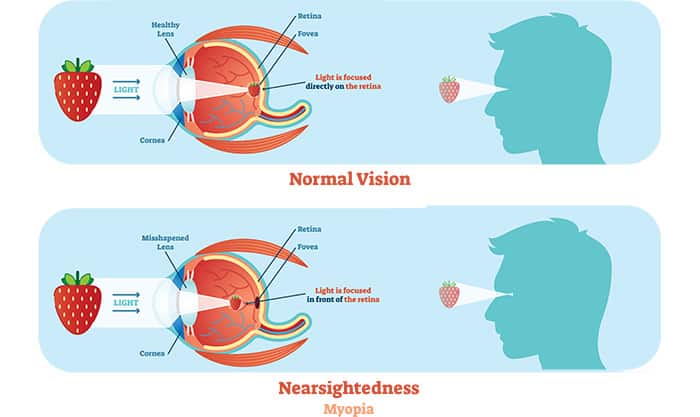
Nearsightedness, or myopia, as it is medically termed, is a vision condition in which people can see close objects clearly, but objects farther away appear blurred. People with myopia can have difficulty clearly seeing a movie or TV screen, a whiteboard in school or while driving.
Myopia occurs if the eyeball is too long or the cornea (the clear front cover of the eye) is too curved. As a result, the light entering the eye isn’t focused correctly, and distant objects look blurred.
Myopia affects nearly 30 percent of the U.S. population. While the exact cause of myopia is unknown, there is significant evidence that many people inherit myopia, or at least the tendency to develop myopia. If one or both parents are nearsighted, there is an increased chance their children will be nearsighted.
Even though the tendency to develop myopia may be inherited, its actual development may be affected by how a person uses his or her eyes. Individuals who spend considerable time reading, working at a computer, or doing other intense close visual work may be more likely to develop myopia.
Generally, myopia first occurs in school-age children. Because the eye continues to grow during childhood, it typically progresses until about age 20. However, myopia may also develop in adults due to visual stress or health conditions such as diabetes.
Myopia may also occur due to environmental factors or other health problems:
- Some people may experience blurred distance vision only at night. With “night myopia,” low light makes it difficult for the eyes to focus properly. Or the increased pupil size during dark conditions allows more peripheral, unfocused light rays to enter the eye.
- People who do an excessive amount of near-vision work may experience a false or “pseudo” myopia. Their blurred distance vision is caused by overuse of the eyes’ focusing mechanism. After long periods of near work, their eyes are unable to refocus to see clearly in the distance. Clear distance vision usually returns after resting the eyes. However, constant visual stress may lead to a permanent reduction in distance vision over time.
- Symptoms of myopia may also be a sign of variations in blood sugar levels in people with diabetes or may be an early indication of a developing cataract. A doctor of optometry can determine the cause of the vision problems through a comprehensive eye exam.
How is myopia diagnosed?
Testing for myopia may use several procedures to measure how the eyes focus light and to determine the power of any optical lenses needed to correct the reduced vision.
As part of the testing, you will identify letters on a distance chart. This test measures visual acuity, which is written as a fraction, such as 20/40. The top number of the fraction is the standard distance at which testing is performed (20 feet). The bottom number is the smallest letter size read. A person with 20/40 visual acuity would have to get within 20 feet to identify a letter that could be seen clearly at 40 feet in a “normal” eye. Normal distance visual acuity is 20/20, although many people have 20/15 (better) vision.
Using an instrument called a phoropter, a doctor of optometry places a series of lenses in front of your eyes and measures how they focus light using a handheld lighted instrument called a retinoscope. Or the doctor may choose to use an automated instrument that evaluates the focusing power of the eye. The power is then refined based on your responses to determine the lenses that allow the clearest vision.
Your doctor can conduct this testing without using eye drops to determine how the eyes respond under normal seeing conditions. In some cases, such as for patients who can’t respond verbally or when some of the eye’s focusing power may be hidden, a doctor may use eye drops. The eye drops temporarily keep the eyes from changing focus during testing.
Using the information from these tests, along with the results of other tests of eye focusing and eye teaming, your doctor can determine if you have myopia. He or she will also determine the power of any lens correction needed to provide clear vision. Once testing is complete, your doctor can discuss treatment options.
How is myopia treated?
People with myopia have several options available to regain clear distance vision. They include:
- Eyeglasses. For most people with myopia, eyeglasses are the primary choice for correction. Depending on the amount of myopia, you may only need to wear glasses for certain activities, like watching a movie or driving a car. Or, if you are very nearsighted, you may need to wear them all the time.
- Generally, a single-vision lens is prescribed to provide clear vision at all distances. However, patients over age 40, or children and adults whose myopia is due to the stress of near-vision work, may need a bifocal or progressive addition lens. These multifocal lenses provide different powers or strengths throughout the lens to allow for clear vision in the distance and up close.
- Contact lenses. For some individuals, contact lenses offer clearer vision and a wider field of view than eyeglasses. However, since contact lenses are worn directly on the eyes, they require proper care to safeguard eye health.
- Ortho-k or CRT. Another option for treating myopia is orthokeratology (ortho-k), also known as corneal refractive therapy (CRT). In this nonsurgical procedure, you wear a series of specially designed rigid contact lenses to gradually reshape the curvature of your cornea, the front outer surface of the eye. The lenses place pressure on the cornea to flatten it. This changes how light entering the eye is focused. You wear the contact lenses for limited periods, such as overnight, and then remove them. People with mild myopia may be able to temporarily obtain clear vision for most of their daily activities.
- Laser procedures. Laser procedures such as LASIK (laser in situ keratomileusis) or PRK (photorefractive keratectomy) are also possible treatment options for myopia in adults. A laser beam of light reshapes the cornea by removing a small amount of eye tissue. The amount of myopia that PRK or LASIK can correct is limited by the amount of corneal tissue that can be safely removed.
- In PRK, a laser removes a thin layer of tissue from the surface of the cornea in order to change its shape and refocus light entering the eye.
- LASIK removes tissue from the inner layers, but not from the surface, of the cornea. To do this, a section of the outer corneal surface is lifted and folded back to expose the inner tissue. A laser then removes the precise amount of corneal tissue needed to reshape the eye. Then, the flap of outer tissue is placed back in position to heal.
• Other refractive surgery procedures. People who are highly nearsighted or whose corneas are too thin for laser procedures may be able to have their myopia surgically corrected. A doctor may be able to implant small lenses with the desired optical correction in their eyes. The implant can be placed just in front of the natural lens (phakic intraocular lens implant), or the implant can replace the natural lens (clear lens extraction with intraocular lens implantation). This clear lens extraction procedure is similar to cataract surgery but occurs before a cataract is present. - Vision therapy for people with stress-related myopia. Vision therapy is an option for people whose blurred distance vision is caused by a spasm of the muscles that control eye focusing. Various eye exercises can improve poor eye focusing ability and regain clear distance vision.
If you have myopia, you have a variety of options to correct your vision problem. In consultation with your doctor, you can select the treatment that best meets your visual and lifestyle needs.


